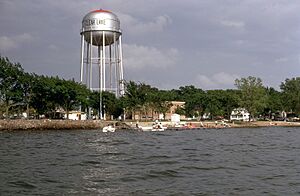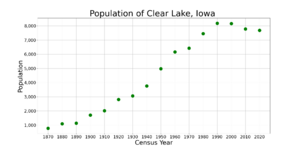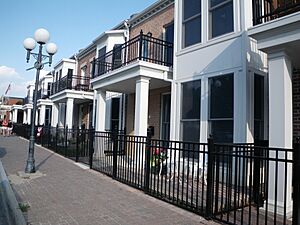Clear Lake, Iowa facts for kids
Quick facts for kids
Clear Lake, Iowa
|
|
|---|---|
|
City
|
|
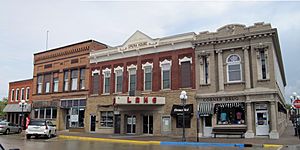
Historic Downtown Clear Lake
|
|
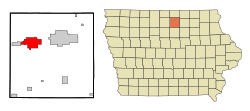
Location of Clear Lake, Iowa
|
|
| Country | US |
| State | |
| County | Cerro Gordo |
| Area | |
| • Total | 13.37 sq mi (34.63 km2) |
| • Land | 10.78 sq mi (27.92 km2) |
| • Water | 2.59 sq mi (6.71 km2) |
| Elevation | 1,237 ft (377 m) |
| Population
(2020)
|
|
| • Total | 7,687 |
| • Density | 713.15/sq mi (275.34/km2) |
| Time zone | UTC-6 (Central (CST)) |
| • Summer (DST) | UTC-5 (CDT) |
| ZIP code |
50428
|
| Area code(s) | 641 |
| FIPS code | 19-14025 |
| GNIS feature ID | 0455465 |
Clear Lake is a city in Iowa, United States. It's located in Cerro Gordo County. The city gets its name from the big lake it sits on. About 7,687 people lived here in 2020.
Clear Lake is a popular spot for visitors. It has many marinas, state parks, and fun places to visit. It's also a major stop along Interstate 35. You can find many restaurants and hotels here.
Contents
History of Clear Lake
The area around Clear Lake was once a summer home for Native American tribes. These included the Dakota and Winnebago people. In 1832, a map was made of the lake during a land survey. This survey was done by Nathan Boone, son of the famous explorer Daniel Boone.
In 1851, Joseph Hewitt and James Dickirson brought their families to the east side of Clear Lake. They built a cabin and became friends with the Winnebago natives. By 1853, more settlers came to the area.
Early Growth of the City
By 1855, the first school in Clear Lake was built. A steam saw mill was also built that year. James Crow opened the first hotel.
By 1870, the town had 775 residents. In 1871, the streets were graded, and sidewalks were made of raised boards. This showed the city was growing fast. The city of Clear Lake officially became a city on May 26, 1871.
The first bandstand in Clear Lake was built in 1877 at the City Park. The town continued to grow and built its first library in 1889. In 1909, Bayside Amusement Park opened. The first North Iowa Band Festival started in 1932.
The Surf Ballroom and Music History
In 1933, the Surf Ballroom opened. It was built on the site of an older ballroom that had burned down. About 700 couples came to the opening dance night. In 1947, the Surf Ballroom burned down again. A new Surf Ballroom was built across the street the next year. The Bayside Amusement Park closed in 1958.
The Day the Music Died
On February 3, 1959, a small plane took off from a nearby airport. It was carrying famous musicians Buddy Holly, Ritchie Valens, and The Big Bopper. They had just performed at the Surf Ballroom in Clear Lake.
The plane crashed soon after takeoff, and everyone on board died. This sad event was later called "The Day the Music Died." This name came from the 1971 song "American Pie" by Don McLean.
In June 1988, a monument was dedicated to the three musicians. About 600 people came to honor them. Clear Lake also renamed a street "Buddy Holly Place."
What is Clear Lake Like?
Clear Lake is located at 43°8′11″N 93°22′48″W / 43.13639°N 93.38000°W. The city covers about 13.44 square miles (34.8 square kilometers). Most of this area is land, and a smaller part is water from the lake.
Weather in Clear Lake
Clear Lake, Iowa, has a humid continental climate. This means it has warm summers and cold, snowy winters.
| Climate data for Mason City Municipal Airport | |||||||||||||
|---|---|---|---|---|---|---|---|---|---|---|---|---|---|
| Month | Jan | Feb | Mar | Apr | May | Jun | Jul | Aug | Sep | Oct | Nov | Dec | Year |
| Mean daily maximum °F (°C) | 25 (−4) |
29 (−2) |
42 (6) |
58 (14) |
70 (21) |
80 (27) |
83 (28) |
81 (27) |
73 (23) |
60 (16) |
43 (6) |
28 (−2) |
56 (13) |
| Mean daily minimum °F (°C) | 7 (−14) |
12 (−11) |
24 (−4) |
35 (2) |
47 (8) |
57 (14) |
61 (16) |
58 (14) |
49 (9) |
37 (3) |
24 (−4) |
11 (−12) |
35 (2) |
| Average precipitation inches (mm) | 0.82 (21) |
1.00 (25) |
2.23 (57) |
3.75 (95) |
4.68 (119) |
5.14 (131) |
4.70 (119) |
4.04 (103) |
3.27 (83) |
2.45 (62) |
1.88 (48) |
1.24 (31) |
35.20 (894) |
| Average snowfall inches (cm) | 10.8 (27) |
7.7 (20) |
6.0 (15) |
2.7 (6.9) |
0.0 (0.0) |
0.0 (0.0) |
0.0 (0.0) |
0.0 (0.0) |
0.0 (0.0) |
0.4 (1.0) |
4.3 (11) |
9.3 (24) |
41.2 (105) |
| Source: National Centers for Environmental Information | |||||||||||||
People of Clear Lake
Clear Lake is part of the Mason City area. In 2010, there were 7,777 people living in Clear Lake. Most people were White (96.3%). About 25% of homes had children under 18. The average age of people in the city was 46.3 years old.
Fun Things to Do in Clear Lake
- Surf Ballroom: This famous place still hosts concerts. You can also visit it as a tourist. Each February, it holds a special event to honor Buddy Holly, Ritchie Valens, and The Big Bopper.
- Lady of the Lake: This is a special ferry boat. It takes passengers on a fun trip around Clear Lake. It has an enclosed lower deck and an open upper deck.
- Clear Lake Fire Museum: This museum looks like an old fire station. It has a 1924 fire truck and the city's old hand-pulled hose cart from 1883. There's also a memorial for firefighters.
- Guardian Angel Roadside Chapel: This small chapel was built by Jack Kennedy. It overlooks Interstate 35 and is open to everyone every day.
- Clear Lake Arts Center: This center shows art from local and regional artists. You can also buy art or take art classes here.
- PM Park: This place started as a camp in 1914. Now it's a historic place to eat and stay.
- Central Gardens of North Iowa, Inc.: This garden has over 20 different themed gardens. It covers almost 3 acres of land. It's free to visit from May 1 to October 31. They also offer many free activities and programs.
- Lake Theatre: This is a historic movie theater with one screen. It used to be an Opera House and became a movie theater in 1935.
Schools in Clear Lake
Clear Lake has a public school district. There are three schools:
- Clear Creek Elementary School: For preschool through 5th grade.
- Clear Lake Middle School: For grades 6 through 8.
- Clear Lake High School: For grades 9 through 12.
There is also an alternative school program called Lakeside Alternative. It works with a nearby school district. Clear Lake Classical is a private school for pre-kindergarten through 8th grade. It offers a Classical Christian education.
How Clear Lake Works
Transportation
Clear Lake is located on Interstate 35. It's about halfway between the Twin Cities and Des Moines, Iowa. U.S. Highway 18 also runs through the city.
You can also find public bus services in Clear Lake. Jefferson Lines is a private bus service that stops here. The Mason City Municipal Airport is right next to Clear Lake.
Two freight train lines run through the city. The Canadian Pacific Railway operates one line. The Iowa Traction Railway is a shortline railroad that connects Clear Lake and Mason City.
City Services
Alliant Energy provides electricity and natural gas for the city. They have a power plant southeast of the city.
The Clear Lake Sanitary District handles sewage treatment. Wastewater is cleaned and disinfected. Some of the cleaned water is used for cooling at the Alliant Energy plant.
Local companies provide phone, cable TV, and internet services. The city provides water from wells. Waste collection services are also provided by the city. Trash is taken to the Landfill of North Iowa.
Famous People from Clear Lake
- Carl S. Bates (1884–1956): An aviation pioneer and inventor.
- Richie Hayward (1946–2010): A founding member of the rock band Little Feat.
- Will Kirk Kaynor (1884–1929): A U.S. Representative for Massachusetts.
- Milo Knutson (1917–1981): A mayor and state senator in Wisconsin.
- Max McGraw (1883–1964): The founder of McGraw-Edison and Centel.
- Robert Allan Phillips (1906–1976): A doctor who developed a treatment for cholera.
See also
 In Spanish: Clear Lake (Iowa) para niños
In Spanish: Clear Lake (Iowa) para niños


